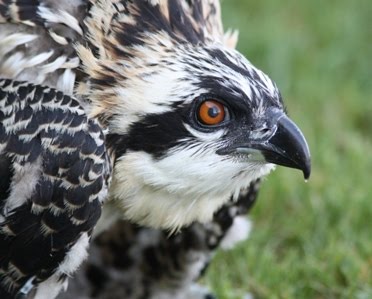The last few weeks seem like a blur...so much happening and it's hard to get around to writing about it all. Last week I got to spend another day in the field with one of our great volunteer monitors. I love doing that, watching the birds together, figuring out what is going on, explaining behaviors that I just can't explain in an email. Answering questions, and catching up on our personal lives too. Thanks Alice! Yesterday I also had a chance to meet with a science teacher at a school that has a nest on the ballfield lights so he could view thru my scope and we could talk about the birds. It's so important to make these connections in the community...I wish it happened more. I consider it part of my field work. And I meet such interesting people! This man was breeding homing pigeons and he released a flock of 29 that were "in training". Why didn't I take photos? I was amazed at how moving it was to watch this flock of pure white birds circling above , getting their bearings before they headed home. He told me later they all seemed to have arrived. Thanks Erik!
Then I met with a new volunteer monitor who has had past experience on an osprey research project in the 80s....we toured a few nests and talked about the project, (ours and hers) the birds, the politics, and our personal lives. So much fun to introduce my osprey friends to her, since she already understood so much about osprey behavior and clearly, she already loved them! Welcome, Nancy!
Of course sprinkled in between all that and the bandings, were my regular nest checks.
More nest failures, more head counting....some going up (a little third head popping up!), and some going down. When new nests pop up at this time of year I have to be careful about identifying the adults when possible, if they are banded. This is when those frustration nests start to be found and if a pair has been counted earlier on another nest, they can't be counted again without artificially inflating the numbers and making it appear as if our population is larger than it really is. When we count nests, we are not really counting how many piles of sticks....we are counting nesting territories, which is really counting nesting pairs of Ospreys. If one or both of the pair has a band and if those bands were read earlier at another nest where eggs were laid, and then after a nest failure for one reason or another, they are seen building another nest, we do NOT count that as another occupied territory. It is just a secondary nest within those birds territory. Now, as we have fewer and fewer banded birds, this gets harder of course, but while we do have banded birds, we need to be careful about this if we are interested in accurate research. Of course it takes time to read bands, but if we have banded birds we sure as heck should be reading those bands! They are there to help us understand Osprey behavior! I keep meaning to write about research methods and terminology....tho it may not be so interesting to some of the people who read this page, I like to do a little educating about all that for the volunteer monitors. It is important. We do need to think about the methods we use, the way we count things and analyze the data. I have learned so much about this topic from one of the best, Sergej Postupalsky, who wrote an important article on this topic many years ago. He studied the Ospreys in Michigan for over 50 years and he has been a mentor to me. He has made me a better scientist! I re read his published papers and his emails all the time. A deep bow of gratitude to him.








